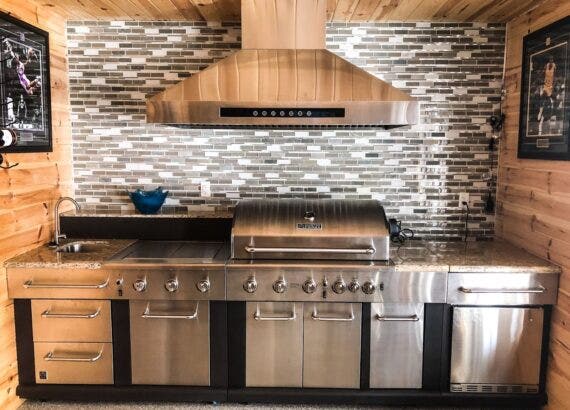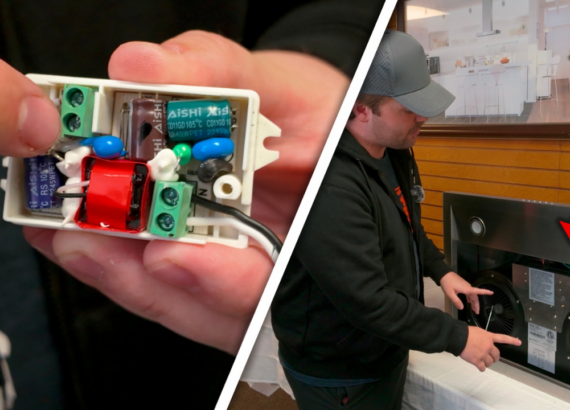The Best Way to Clean a Greasy Ceiling: Quick and Effective Tips

Greasy ceilings are a common issue in kitchens, especially after cooking countless meals that release oil and grease into the air. Over time, this buildup can become unsightly and even cause unpleasant odors. Fear not, you can tackle this problem effectively and bring back the sparkle to your kitchen ceiling.

Well, gather the necessary supplies, such as a vacuum cleaner, cleaning solution, and appropriate tools for reaching the ceiling. A good homemade cleaning solution is mixing 2 tablespoons of white vinegar or ammonia with 1 quart of warm water, or, even simpler, warm water with a few squirts of dishwashing soap. This will help in gently removing the grease from the delicate surfaces of the ceiling without causing damage.
Ensure you cover your floors with a tarp or trash bags to protect them from any dripping solution during cleaning. Now that you’re prepared, it’s time to roll up your sleeves and follow the methods outlined to make your ceiling grease-free and fresh once again.
Check out our article on Best Kitchen Degreasers right here.
Table of Contents
Understanding Different Ceiling Types
Textured Ceilings
Textured ceilings are popular in many homes due to their visual appeal and ability to hide imperfections. There are several types of textured ceilings, including knockdown, orange peel, and swirl. When cleaning your textured ceiling, it’s crucial to avoid using a brush or harsh cleaning materials that could damage the surface. Instead, use a soft cloth or sponge dampened with a mild cleaning solution, like a mixture of warm water and dishwashing soap. Gently pat the ceiling, being careful not to scrub too hard. Remember, it’s important to always start with the gentlest approach to protect your ceiling’s texture.
Popcorn Ceilings
Popcorn ceilings, also known as acoustic or cottage cheese ceilings, have a rough texture resembling popcorn. These ceiling surfaces are prone to collecting dust and grime. When cleaning a popcorn ceiling, use a vacuum cleaner with a soft brush attachment to remove loose dirt and debris. You should avoid wet cleaning methods, as water can cause the popcorn texture to soften and crumble. If you must use a damp cloth, test a small inconspicuous area first to see how the ceiling material reacts. Keep in mind that older popcorn ceilings may contain asbestos, which can be hazardous if disturbed. In such cases, consult a professional for cleaning or removal.
Smooth Ceilings
Smooth ceilings are the easiest type to clean as they usually have a flat or slightly textured surface. To clean your smooth ceiling, start by dusting the surface using a microfiber cloth, then use a damp cloth with a mild cleaning solution like a mixture of warm water and dish soap or lemon juice. Wipe the ceiling gently to avoid damaging the paint or plaster, and don’t forget to pat it dry with a clean, soft cloth to remove any excess moisture.
Remember, always customize your cleaning approach based on your specific ceiling type and the advice provided above, considering factors like the condition of the surface or whether it has been previously painted or sealed.
Gathering Necessary Supplies and Equipment
Before you start cleaning your greasy ceiling, it’s essential to gather all the necessary supplies and equipment. This will make the cleaning process more efficient and safer.
Ladders and Stepladders
First, you’ll need a sturdy ladder or stepladder to reach the ceiling comfortably:
- Extension ladder: This is ideal for high ceilings and allows you to adjust the height as needed.
- Stepladder: A folding stepladder works well for lower ceilings as it’s easier to set up and move around.
Make sure to have someone hold your ladder for stability while you’re on it.
Cleaning Solutions and Tools
Next, prepare the right cleaning solutions and tools to effectively remove the grease:
- Baking soda: Mix baking soda with water to create a paste, which works great for removing tough grease stains.
- Vinegar: White vinegar mixed with water can also help cut through grease and eliminate odors.
- Liquid dish soap: This can be added to your vinegar and water solution for added cleaning power.
- Spray bottle: Fill a spray bottle with your chosen cleaning solution for easy application.
Here are some essential tools to use during the cleaning process:
| Tool | Purpose |
|---|---|
| Vacuum | To remove loose dust and debris from the ceiling |
| Duster | To clean off any remaining dust after vacuuming |
| Paint roller | To apply your cleaning solution evenly to the ceiling |
| Microfiber cloth | For wiping away any residue or excess cleaning solution |
| Lint roller | To remove lint and fibers from your microfiber cloth |
| Tarp or drop cloth | To protect your floors and furniture from drips |
Don’t forget personal protective equipment such as a mask to avoid inhaling any dust.
Now that you have your supplies and equipment ready, you can start tackling that greasy ceiling. Remember to work in small sections for better control, and don’t hesitate to take breaks when needed. Good luck!
Preparation for Cleaning
Before you begin cleaning your greasy ceiling, it’s essential to prepare the area and remove any dust and cobwebs that may be present. This will ensure a more effective cleaning process.
Protect Surrounding Area
Before starting the cleaning process, make sure to protect the surrounding area of your ceiling. Here are some steps to follow:
- Move any furniture that may be under the area you will be cleaning.
- Cover the floor with a tarp or drop cloth to catch any falling dust or debris.
- If you have any delicate items or electronics in the area, consider covering them with a plastic sheet to avoid damage.
Remove Dust and Cobwebs
It’s important to remove dust and cobwebs from your ceiling before using any cleaning solution. This step will help to prevent the spread of dust and make it easier to clean the grease. Follow these steps:
- Use a feather duster or a soft-bristle brush to gently remove loose dust and cobwebs from the ceiling. Be careful not to press too hard, as this could damage the surface of the ceiling.
- If your ceiling has any corners or hard-to-reach areas, consider using an extendable duster or a vacuum cleaner with a brush attachment.
- Give special attention to any areas with visible stains or heavy dust buildup, as these may require extra cleaning.
After completing these steps, your ceiling should be free of dust and cobwebs, and you’ll be ready to start cleaning the grease. Remember, preparation is key to achieving the best results, so taking your time with these steps will be worth the effort.
Cleaning Techniques for Greasy Ceilings
In this section, you’ll find different cleaning techniques to help remove tough stains and grease buildup from your ceiling. Let’s start with a simple but effective method.
Cleaning with Dish Soap and Warm Water
A simple and gentle cleaning mixture for your greasy ceiling is warm water and a few squirts of dishwashing soap. Dish soap is designed to remove grease from delicate surfaces, such as your ceiling. Follow these steps:
- Mix a few drops of dish soap with warm water in a bucket.
- Dip a soft microfiber cloth in the solution and wring it out so it’s damp, not soaking wet.
- Gently wipe the ceiling, taking care not to apply too much pressure, as this may damage the paint.
- Rinse the cloth frequently to avoid reapplying grease on the ceiling.
- Dry the area with a clean, dry cloth or let it air dry.
Using Vinegar and Baking Soda for Stubborn Stains
For stubborn grease stains, a mixture of vinegar and baking soda can be more effective. Both vinegar and baking soda are excellent all-purpose cleaners and natural degreasers.
- Mix equal parts of water and white vinegar in a spray bottle.
- Spray the solution onto the stained area, and let it sit for a few minutes.
- Make a paste of baking soda with water. Apply this paste to a soft cloth or sponge.
- Gently scrub the stain with the baking soda paste.
- Wipe the area with a damp cloth to remove residue.
- Dry with a clean, dry cloth or let it air dry.
Spot Cleaning Popcorn Ceilings
Popcorn ceilings can be challenging to clean, as they have a rough texture that may loosen and fall off during cleaning. Here are some tips for spot cleaning a dirty popcorn ceiling:
- Prep the room by covering the furniture and floor with drop cloths or plastic tarps.
- Use a vacuum cleaner with a brush attachment to gently remove dust and debris from the ceiling.
- For small stains, use a soft cloth or sponge dampened with water or a mild cleaner like dish soap or vinegar solution.
- Gently dab, rather than scrub, to avoid damaging the texture.
- Once clean, let the area air dry.
Now you have three different cleaning techniques tailored for various types of ceilings and stain severity. Stick with these methods, and you’ll find cleaning a greasy ceiling a breeze.
Finishing Touches and Repainting if Necessary
Drying and Assessing the Results
After cleaning your greasy ceiling, it’s crucial to let it dry thoroughly. This can take several hours or even a day, depending on the humidity and air circulation in the room. Once it’s dry, assess the results:
- Check for any remaining grease or grime. If you still see stains, you might need to repeat the cleaning process with a stronger cleaning solution or technique.
- Examine the paint on the ceiling. If it has become dull or lost its original color, you might need to consider repainting.
By taking your time and being thorough, you can ensure your ceiling looks as good as new.
When to Consider Repainting
If you’ve cleaned your ceiling and still notice some imperfections, it might be time to consider repainting. Here are a few signs that repainting is necessary:
- Persistent stains: If grease or grime stains don’t come off even after multiple cleaning attempts, repainting might be the only option to restore the ceiling’s appearance.
- Peeling or flaking paint: If the paint on the ceiling is peeling or flaking, this is a clear sign that it’s time to repaint.
- Loss of color: If the paint has faded or discolored, a fresh coat can bring the ceiling back to its original state.
When repainting your ceiling, be sure to follow these steps:
- Prepare the ceiling: Clean the surface again to remove any remaining grease or grime. You may also need to repair any cracks or damage before painting.
- Prime the ceiling: Priming helps to ensure better adhesion of the paint to the surface and will cover any stains or imperfections.
- Select the appropriate paint: Choose a durable and washable paint, preferably with a satin or semi-gloss finish to make future cleaning easier.
- Apply the paint: Use a roller with an extension handle to make the process less messy and physically taxing. Apply multiple thin coats, allowing each layer to dry before applying the next.
By following these steps, you can have a clean, fresh, and grease-free ceiling in your kitchen or any other room that has been affected by grease buildup.
Precautions and Safety Tips
Handling Asbestos in Older Ceilings
When cleaning greasy ceilings, it’s crucial to take several precautions and safety tips into account, especially when dealing with older ceilings that may contain asbestos. Asbestos was commonly used in construction materials, such as popcorn ceilings, until the 1970s. If your home was built before this time, there is a chance that your ceiling might have asbestos.
Determine If Your Ceiling Contains Asbestos
Before attempting to clean a greasy ceiling, determine if it contains asbestos by:
- Checking the age of your home or building
- Consulting with previous owners or maintenance records
- Hiring a professional to perform asbestos testing
If you find your ceiling has asbestos, proceed with caution. Do not disturb it as doing so could release harmful fibers into the air, posing health risks.
Consider Hiring a Professional
When dealing with asbestos-containing materials, it’s often best to hire a licensed asbestos abatement professional to manage the situation. They have the necessary equipment and training to safely handle asbestos-containing materials while ensuring minimal disturbance.
General Precautions And Safety Tips
Regardless of the type of ceiling, following these general precautions and safety tips will ensure a safe cleaning process:
- Always use a sturdy, secure ladder to reach the ceiling.
- Wear appropriate protective gear, such as gloves, eye protection, and a dust mask.
- Test a small, inconspicuous area of the ceiling first to ensure the cleaning solution won’t damage the surface.
- Never mix different cleaning products, as this may create toxic fumes.
Following these precautions and keeping safety in mind while cleaning greasy ceilings will not only protect your home but also safeguard your health. So, go ahead and enjoy a cleaner, fresher living space while maintaining your safety.
Tips for cleaning greasy blinds here.
FAQs
Q: What cleaning solutions can I use to remove grease from my ceiling?
A: There are several cleaning solutions you can use to effectively clean a greasy ceiling:
- Mix 2 tablespoons of baking soda and 2 tablespoons of water to make a paste.
- Apply lemon juice to your ceiling, let it sit for a while, and wipe it down gently with a microfiber cloth. You can also use salt for more powerful scrubbing.
- Trisodium phosphate (TSP) can be used to clean soot stains.
Remember to always test a small, inconspicuous area first to make sure your chosen cleaning solution won’t damage your ceiling.
Q: What tools should I use to make cleaning my ceiling easier?
A: The following tools can make cleaning your ceiling a breeze:
- Microfiber cloths: these are gentle on surfaces, yet effective at removing dirt and grease.
- A long-handled duster or broom to reach higher areas without a ladder.
- A vacuum cleaner with an extension hose and brush attachment to remove loose dust and debris.
Q: How often should I clean my ceiling?
A: The frequency of cleaning your ceiling depends on various factors, including:
- The type and texture of your ceiling surface (smooth, popcorn, etc.)
- The level of foot traffic in your home
- Whether or not you cook frequently, which can release airborne grease and grime
Generally, it’s a good idea to clean your ceiling at least once a year or more frequently if you notice excessive build-up or stains.
Q: How should I maintain my ceiling after cleaning?
A: After cleaning your ceiling, consider the following tips for maintaining its cleanliness:
- Regularly vacuum or dust the ceiling to prevent build-up
- Ventilate your kitchen while cooking to minimize grease and grime accumulation.
- Promptly address any water leaks or moisture issues that could cause stains and mildew growth.
Remember, a well-maintained ceiling not only looks nicer, but also contributes to a cleaner and healthier living environment.







Comments are closed.